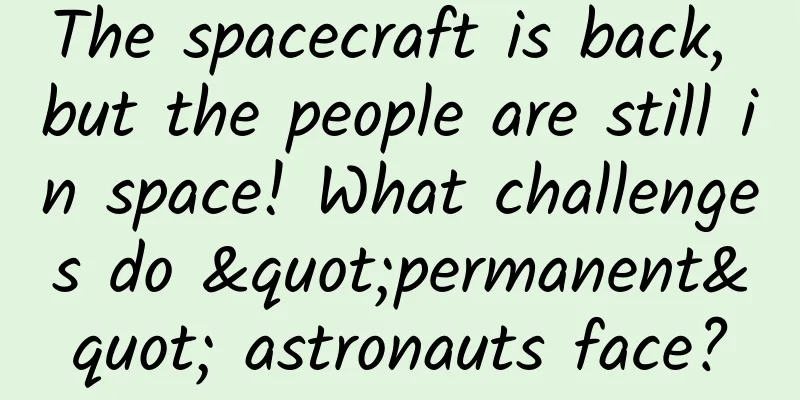The spacecraft is back, but the people are still in space! What challenges do "permanent" astronauts face?

|
Astronauts trapped in space?! The spacecraft carrying them returned... What’s going on? According to CCTV News, Boeing's "Starliner" spacecraft landed on Earth on September 7, marking the end of the spacecraft's first manned test flight mission. For safety reasons, the two astronauts sent into space by the spacecraft were unable to return . They were originally scheduled to "go on a business trip" for 8 days, but now they will work on the International Space Station for about 8 months. The "Starliner" separated from the International Space Station on the 6th. After about 6 hours of flight, it successfully completed the deorbit operation and re-entered the Earth's atmosphere. It landed in the White Sands Spaceport area in New Mexico, USA in the early morning of the 7th Eastern Time (noon of the 7th Beijing Time). ▲"Starliner" spacecraft (pictured in CCTV News client report) After the spacecraft landed, NASA held a press conference. Stick, head of NASA's commercial manned program, said at a press conference that although the Starliner returned safely, it was the "right decision" not to allow the two astronauts to return on the spacecraft. ▲Barry Wilmore (left) and Sunny Williams (right) trapped in the space station The two people who accidentally went on a long business trip were NASA astronauts Suni Williams and Butch Wilmore. When they launched on Boeing's Starliner spacecraft on June 6, they were originally scheduled to stay at the International Space Station (ISS) for only eight days to carry out their space missions. But now, after being forced to extend their stay by dozens of days, they may be forced to stay until 2025! Because several thrusters of the "Starliner" spacecraft they were on malfunctioned on the way to the space station. What challenges will astronauts face when trapped in space? Some people think that enjoying the beauty of the solar system and floating around in zero gravity in the space station is also a good life experience. But in fact, the two astronauts, Sunny Williams and Butch Wilmore, will face a longer test in space. Although the scenery in space is breathtaking, the International Space Station is not an ideal holiday destination. The small space and weightless environment make every day of being stranded difficult, which makes people "worry" for them. Test 1: A sleeping pod the size of a “telephone booth” On Earth, sleeping is the simplest thing. But in the weightlessness of space, lying down or resting your head on a pillow is almost impossible. On the International Space Station, the main sleeping area for astronauts is located in the "Harmony" module of the space station, and each sleeping module is the size of a telephone booth. Astronauts cannot lie comfortably in bed like us. They have to use sleeping bags to secure themselves in the cabin because floating in the narrow cabin can easily collide with various instruments and equipment, causing danger. Test 2: A bit complicated toileting On the International Space Station, going to the toilet is jokingly called the "orbital toilet." Unlike toilets on Earth, toilets in space are divided into two containers for solid and liquid waste. Astronauts use a tube with a funnel to collect urine, while solid waste is handled through a small hole with a cover and fan suction. Although the system is safe and hygienic, it takes some practice to use and can be a bit awkward and messy. Also, the delicate process of pumping can be uncomfortable. Once astronauts have used the toilet, the feces is sucked into waste bags where it is dehydrated and compressed. The bags are sometimes sent back to Earth for study but usually burn up in the atmosphere. Urine goes through the station's water recovery system and is converted back into usable water. Test 3: Showering in space basically depends on "wiping" In space, showering is impossible. Because there is no gravity, the surface tension of water causes it to act like a sticky mass, forming large floating spheres that cling to nearby surfaces. Astronauts can only scrub their hair twice a day with a damp towel and use waterless shampoo to cleanse their hair. Because you have to prevent toothpaste foam and water droplets from floating around in the microgravity environment of space, and floating waste water is dangerous to electronic equipment, astronauts have to spit the toothpaste foam onto a paper towel and throw it away after brushing their teeth in space. Of course, if you like the edible toothpaste foam, you can swallow it directly. Test 4: Uncomfortable "space sickness" Unlike on Earth, gravity is very weak in the International Space Station and spacecraft. The resulting symptoms include headaches, nausea and vomiting, known as "space sickness". On Earth, our body's balance is greatly affected by gravity. Deep in the ear is a small but important balance organ called the "vestibule". This organ converts information about gravity and acceleration on the body into electrical signals that are sent to the brain. On Earth, the brain has been receiving information about gravity from here to help maintain the body's balance. In space, where gravity is very weak, information from the vestibular organs changes, causing confusion in the brain, which in turn causes space sickness. However, this state does not last long. After staying in space for a few days, space sickness will gradually ease. The severity of space sickness varies from person to person, and some people will not experience space sickness. In addition, after returning to Earth, affected by the Earth's gravity, "gravity sickness" symptoms similar to space sickness will also occur. Test 5: Facial swelling is common in space Facial edema is common in space. On Earth, humans do not float because of the pull of gravity. In fact, on Earth, the flow of body fluids such as blood is also affected by gravity, and more moves to the lower part of the body. When reaching space, due to the decrease in gravity, body fluids will accumulate in the upper body, causing facial edema. Due to this effect, the nasal mucosa will also swell, so astronauts often experience "nasal congestion". After a period of time in space, fluid balance will be restored and facial edema will usually disappear within a few weeks. On the contrary, when astronauts return to Earth, they often experience dizziness (orthostatic hypotension). In space, because the heart muscle can pump blood with less force, it will degenerate. After returning to Earth, because the gravity on Earth is greater than in space, it becomes difficult for the heart to pump blood to the head, causing dizziness. Test 6: Weakened bones and muscles Staying in space for a long time can cause bone and muscle degeneration. On Earth, due to the force of gravity, we constantly use the muscles and bones of our legs and waist to resist this force. In space, where gravity is very weak, you can maintain your posture even without standing on your two legs, and you don't need to use your legs when moving. Staying in space for a long time can cause muscle weakness and bone loss. Therefore, scientists are studying drugs to prevent astronauts from losing bone mass. In addition, in order to prevent astronauts' muscles and bones from weakening, they need to exercise for about 2 hours a day during their stay on the International Space Station. Test 7: The stress of living in a small space Compared to previous spacecraft, the living space of the International Space Station (ISS) has been greatly expanded. However, compared with life on the ground, the scope of activities is still very limited. Living and working with other astronauts in a small space for a long time for several months may accumulate stress without you even realizing it. The astronauts on the ISS come from various countries such as Russia, the United States, Canada, Europe, and Japan. Language barriers and cultural differences may also cause stress. In order to reduce the stress of astronauts, they also strive to create an environment for communication with family and friends in space, and enrich the variety of space food. When will the two astronauts be able to return to Earth? The Starliner manned space program has not been going smoothly. After several delays, the first manned test flight was carried out on June 5, carrying two American astronauts, and arrived at the International Space Station on June 6. The Starliner was originally scheduled to return to Earth on June 14, but due to problems such as thruster failure and helium leakage, the return time was repeatedly postponed. In the end, NASA decided to let the Starliner return without manned on September 6, and the two astronauts will return in February next year on the Dragon spacecraft of the American Space Exploration Technology Company under the name of Elon Musk. The Dragon spacecraft is scheduled to be launched no earlier than September 24, and the number of astronauts on board will be reduced from the original four to two to make room for the two astronauts stranded in space. Bloomberg commented that NASA's determination that Musk's spacecraft was safer had dealt Boeing a humiliating setback. Since the retirement of the US space shuttle in 2011, the US has vigorously developed commercial manned spaceflight. In 2014, Boeing and SpaceX received contracts from NASA for manned spacecraft projects to build the Starliner manned spacecraft and the manned version of the Dragon spacecraft to transport US astronauts to the International Space Station. According to the Associated Press, NASA's goal is to have Boeing and SpaceX take turns to transport astronauts to and from the International Space Station once a year before the International Space Station is deorbited and recovered in 2030. The Dragon spacecraft completed its first manned test flight in 2020 and has carried out nine regular commercial manned space missions so far, transporting dozens of astronauts. However, the Starliner spacecraft project has repeatedly encountered setbacks and has been delayed by seven years than planned. NASA originally planned to conduct final certification for the Starliner to carry out regular commercial manned space missions and regularly transport astronauts to and from the space station after the Starliner mission. Regarding whether the Starliner will be allowed to carry astronauts for another test flight scheduled for August next year, Stick said it is too early to talk about this topic now. NASA needs time to analyze the data and evaluate what changes need to be made to the design and flight mode of the Starliner. Source: Xinhuanet, CCTV News Client, Institute of Physics, Chinese Academy of Sciences, "Youth Listen to the World" WeChat public account, etc. Editor: David Duan |
<<: The cancer incidence rate in 30-year-old women is about twice that of men! What is the reason?
Recommend
A complete guide to 5 types of fission gameplay for user growth (Part 2)
A complete guide to 5 types of fission gameplay f...
Xiaohongshu advertising strategy notes
How to make a delivery strategy? This problem has...
Bed bugs are crawling all over the floor, and a bite will spit blood! Bed bug crisis breaks out in many countries, and it's actually very close to you
Recently, news about a "bed bug crisis break...
Internet finance is not a "naughty child"
Ma Huateng once pointed out that for many traditi...
Orange high temperature warning issued! How to prevent heat stroke scientifically?
At 18:00 on the 22nd, the Central Meteorological ...
Large capacity, zero attenuation, CATL Tianheng energy storage system released
On April 9, CATL released the world's first e...
Global supercomputer competition: Europe's most powerful computer performance is only 2.5% of China's
Supercomputers have become one of the hottest area...
High-conversion information flow account building routine, just use it directly!
Recently, a friend left a message to complain: Th...
Digging the root | The sky-high-priced "anti-cancer injection" can "eliminate" cancer cells with one shot? Is it true or false? Find out in one article today!
gossip In recent years, a kind of "anti-canc...
Tech Neo Technology Salon No. 16 - Automated Operation and DevOps
【51CTO.com original article】 [51CTO original arti...
How to carry out advertising in the medical beauty industry? Case Analysis
Today, Qingguajun will share with you the analysi...
Su Xiaotang’s private domain traffic operation secrets are fully revealed!
At every offline get out of class, there are alwa...
Musk predicts that the AI industry will shift from silicon shortage to electricity shortage, and China will be the biggest winner?
With the rapid development of artificial intellig...
Will there be a space version of ChatGPT?
ChatGPT is very popular now. As an artificial int...
Artificial intelligence is "entering" the legal profession, will it replace lawyers and judges?
On August 24, 2023, the Science Popularization Ch...









